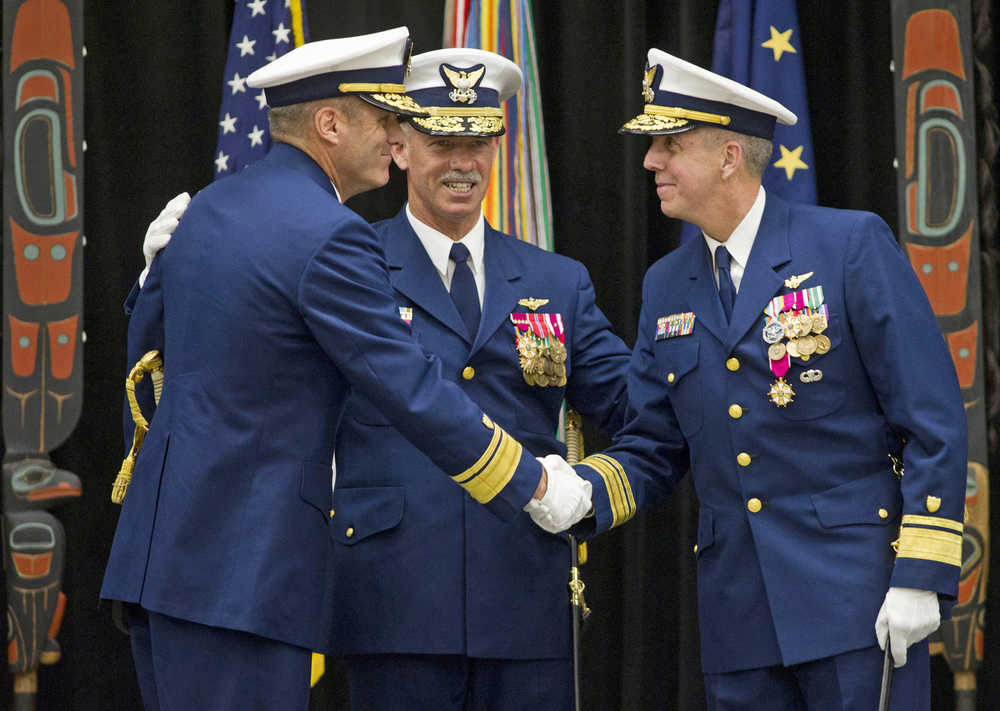Rear Adm. Daniel Abel got a standing ovation for his leadership of the U.S. Coast Guard 17th District over the past two years.
“His perspective and leadership is evident in everything that’s going on in this state with the Coast Guard,” Vice Adm. Charles Ray, Pacific Area Commander, said during the change of command ceremony Wednesday at Elizabeth Peratrovich Hall.
Abel assumed the duties of Commander of the Coast Guard 17th District in June 2014.
“When he got here, he established his vision for what the Coast Guard would be about during his command … that the Arctic is important to us. This is not a one-time thing, it’s not here today, gone tomorrow; this is our mission forever,” Ray said.
[See photos from the event here]
In an interview after the ceremony, Abel said his biggest achievement in Alaska was his work preparing the Arctic for increased ship traffic given the melting ice. He was involved in developing Polar Code, a set of new international regulations for all ships that enter polar waters.
“We need to enforce that and make sure we have the capacity to do that. It’s one thing to have the regulations; it’s another to enforce it,” Abel said.
He established the Arctic Waterways Safety Committee, chaired by former Kotzebue mayor Willie Goodwin, who gave the invocation at the ceremony. The committee was established to ensure that all the stakeholders in the North Slope have a say in what happens and the regulations that are up there.
[Abel takes control of Alaska Coast Guard]
Abel said it was about “hearing from the subsistence communities, borough and village leadership, and industry with one voice, and asking them, ‘What do you need from your Coast Guard?’”
He said the last pillar of this Arctic work was the Port Access Route Study, which determines how traffic should move through the Bering Strait.
“It’s basically traffic lanes that will go all the way from Dutch Harbor, up through the Bering Strait, and go left and right. We worked with environmental groups and subsistence folks, and the biggest thing we could give is we have bottom-mapped exclusively up and around this route,” Abel said.
He recognized that his two years as top leader of the Coast Guard in Alaska came at a crucial time for the Arctic.
“It’s the turning point. The president came up, the recognition that we need more ice breakers and when I got here, the comment was, ‘We never do search and rescue in the Arctic.’ Well, we’re doing search and rescue in the Arctic now, so we’ve turned a page,” Abel said.
[Coast Guard anticipates high-tech future with Arctic Center]
As commander of the Coast Guard in Alaska, Abel was responsible for 44,000 miles of shoreline and 3.9 million square miles of ocean. He oversaw 988 search and rescue missions, including the evacuation of a mariner injured 475 miles northwest of Barrow. Vice Adm. Ray said it was “the northernmost rescue in recorded history.”
Abel said the Coast Guard members involved in those missions saved 335 lives and assisted more than 1,300 people.
“Those are mothers, fathers, sons, daughter, grandpas, granddaughters, uncles, aunts — 1,600 Alaskan families that are whole today because of the men and women of the 17th District,” he said.
Abel and his family will move from Alaska to Miami, Florida, where he’ll be Director of Operations for the U.S. Southern Command.
Taking over as commander of the Coast Guard 17th District is Rear Admiral Michael McAllister, who moved from Colorado Springs, Colorado, where he was deputy director of operations for the U.S. Northern Command. The Northern Command includes all of Alaska, Canada, United States, Mexico and Bahamas.
In that role, McAllister became familiar with Arctic operations.
“Most recently at the U.S. Northern Command, we did a lot of work preparing for the opening of the Arctic to increase maritime traffic, to increase activity by all nations,” he said in an interview after the ceremony.
McAllister said it’s important to understand an environment before deciding what to do in it.
“I had the opportunity to visit Kotzebue and Nome about a month and half ago and see the impacts of the changing Arctic environment in terms of the severity of storms that were coming through, the impacts on subsistence fishing. And those are things that we’re going to have to include in our calculations in terms of how we regulate the environment and how we operate in it,” he said.
The Coast Guard’s current assets in the Arctic include a high endurance cutter, a medium class ice breaker and two helicopters out of Kotzebue. The Coast Guard recently got support from the Obama administration and Congress to purchase a new icebreaker, which is “one of our most significant needs,” McAllister said.
[Sen. Sullivan seeks to cut wait for new icebreaker in Arctic]
“The presence we have is aligned with the amount of activity that we see today. The future is harder to predict and so we’re preparing for those days when there’s ice-free waters for a more significant portion of the year, and the Coast Guard is very much focused on ensuring we have the right assets to operate that,” he continued.
McAllister’s immediate plans as commander include a trip to Anchorage, another trip to Kotzebue and getting to know other Coast Guard leaders who are more involved in the day-to-day operations of the 17th District.
• Contact reporter Lisa Phu at 523-2246 or lisa.phu@juneauempire.com.

